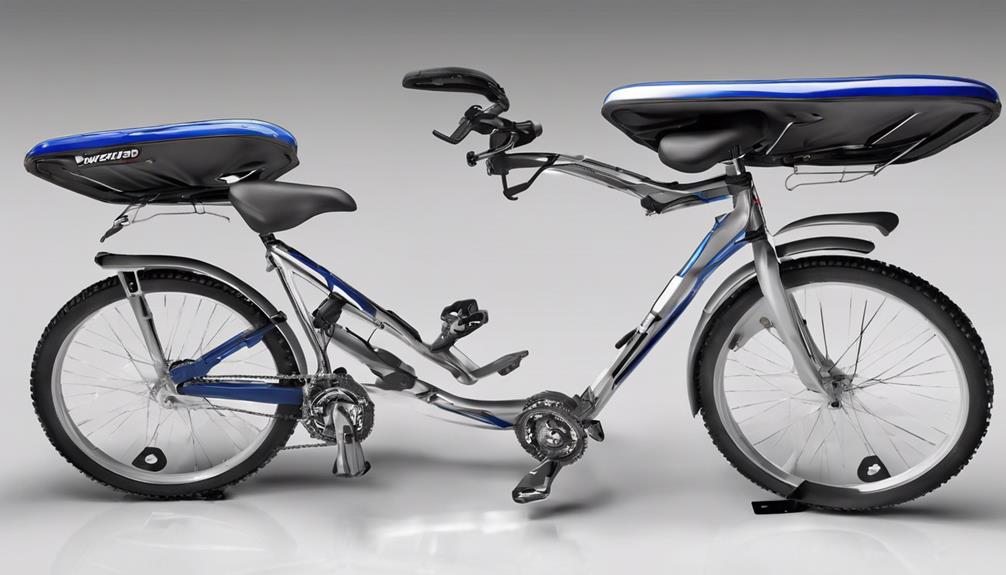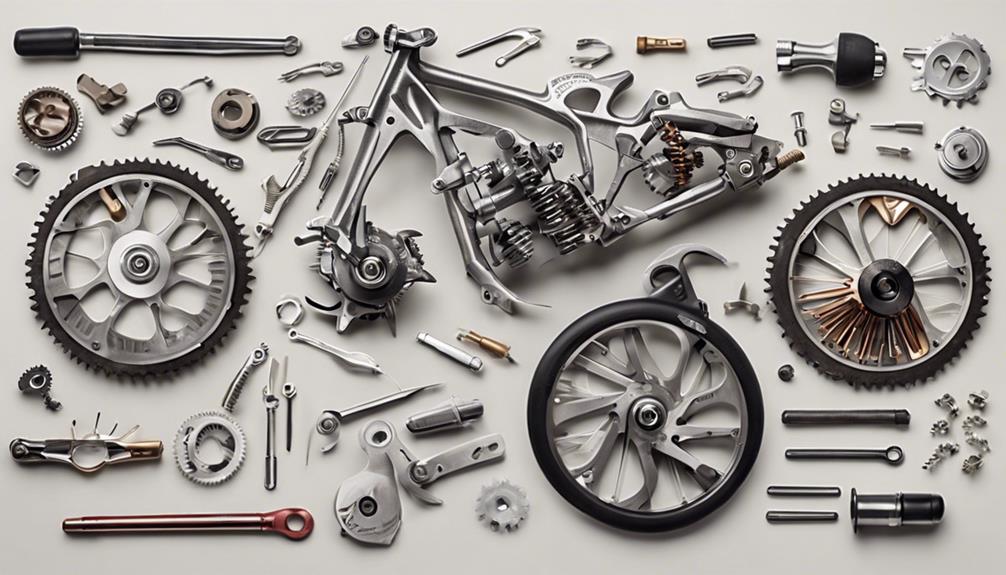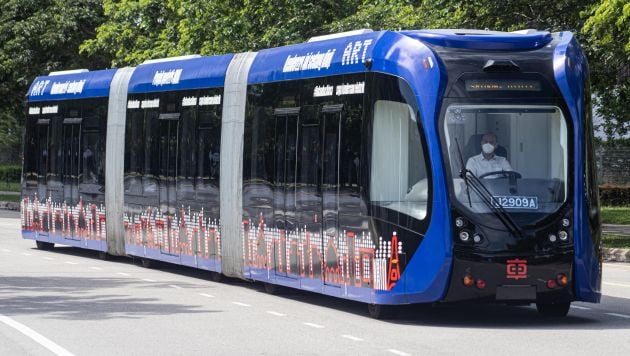Have you ever pondered the intricate balance between the practicality of a Bicycle Roof Rack and the simplicity of a Trunk Rack?
As we dissect the nuances of each option, exploring aspects such as ease of installation, security features, and overall impact on your biking experience, a fascinating comparison emerges.
From safeguarding your bikes during transit to considering the ease of loading and unloading, the choice between these two types of racks can significantly influence your cycling adventures.
Curious to discover which rack aligns best with your biking lifestyle?
Key Takeaways
- Trunk racks are budget-friendly and easy to install, ideal for casual cyclists.
- Roof racks offer better security and protection, suitable for serious cyclists and specific needs.
- Trunk racks provide universal compatibility and accessibility for various vehicles.
- Roof racks offer versatility and stability but come at a higher cost for specialized use.
Ease of Installation and Loading
When comparing the ease of installation and loading between bicycle roof racks and trunk racks, it's important to consider the practical implications for cyclists. Roof racks, while secure once properly mounted, can be challenging to install due to the need for lifting bikes onto the roof of the vehicle. This process might be cumbersome for some cyclists, especially when dealing with heavier bikes. Additionally, the placement of roof racks can alter the car's steering and wind behavior, potentially affecting the vehicle's overall stability.
On the other hand, trunk racks offer a simpler installation process and don't require special tools. Loading and unloading bikes onto a trunk rack is more accessible, as cyclists don't need to lift the bikes to a raised platform. This ease of access not only makes the process more convenient but also provides better visibility of the bikes, enhancing security during transport. Furthermore, trunk racks generally offer lower wind resistance compared to roof racks, which can improve fuel efficiency and driving comfort for cyclists seeking a smoother ride.
Security Features and Bike Protection

Roof racks provide enhanced security features and superior bike protection compared to trunk racks. When considering the safety of your bike and ease of mind while traveling, roof racks offer several advantages over trunk racks:
- Theft Accessibility: Trunk racks are more susceptible to theft due to their accessibility and visibility. Roof racks keep bikes out of immediate reach, reducing the risk of theft significantly.
- Bike Protection in Rear-End Collisions: In the unfortunate event of a rear-end collision, roof racks provide better protection for bikes compared to trunk racks. The elevated position of the bikes on the roof minimizes the impact during such incidents.
- Element Protection: Roof racks shield bikes from elements and debris better than trunk racks. Whether it's rain, dust, or road debris, roof racks offer superior protection, keeping your bike clean and safe during transit.
Considering these factors, roof racks not only enhance security but also prioritize the protection of your bike in various scenarios, making them a reliable choice for avid cyclists.
Affordability and Value for Money

Considering the cost disparity between trunk racks and roof racks, it's evident that affordability plays a significant role in determining the value for money when choosing a bike transportation option. Trunk racks, with their price range typically between $50 to $200, are undeniably a budget-friendly and cost-effective choice for individuals looking to transport their bikes without breaking the bank.
On the other hand, roof racks, priced from $200 to $500 and beyond, offer a more versatile option at a slightly higher cost. While roof racks provide additional features and flexibility, trunk racks deliver excellent value for money, especially for those with simple bike transport needs. The affordability of trunk racks makes them a popular option for casual cyclists or those on a tight budget, offering a practical and efficient solution.
Ultimately, the decision between a trunk rack and a roof rack boils down to individual preferences, budget constraints, and the level of versatility required for transporting bikes.
Compatibility With Different Car Types

For a comprehensive comparison of bike transportation options, understanding the compatibility of roof racks and trunk racks with different car types is essential.
When it comes to choosing the right rack for your vehicle, considering the following factors can help you make an informed decision:
- Roof Rack: Ideal for cars with a factory-installed roof rack system, ensuring a secure fit and stability.
- Trunk Rack: Offers a universal fit, making it suitable for a variety of vehicle types, including sedans, hatchbacks, and SUVs, without the need for additional mounting accessories.
- Hitch Rack: Compatible with most vehicles that have a hitch receiver, providing a convenient and versatile option for bike transportation.
Overall Convenience and Practicality

When evaluating the overall convenience and practicality of bike transportation options, one must carefully consider the ease of use and versatility each rack system offers. Roof racks provide unlimited access to the trunk/hatch even with the bike mounted, offering convenience for daily use. However, trunk racks are generally easier to remove, making them ideal for occasional bike transport needs. For serious cyclists needing to transport multiple bikes, roof racks prove to be more versatile, accommodating up to 4 bikes compared to trunk racks' 2-3 bike capacity. Additionally, trunk racks are a more budget-friendly option, appealing to those looking for an affordable bike transportation solution. It's important to note that while roof racks may impact fuel efficiency due to wind resistance, trunk racks offer lower wind resistance and better gas mileage.
| Aspect | Roof Rack | Trunk Rack |
|---|---|---|
| Access to Trunk | Unlimited access | Limited when fully loaded |
| Versatility | Suitable for up to 4 bikes | Supports 2-3 bikes |
| Budget-Friendly | Higher cost | More affordable |
| Fuel Efficiency | May impact due to wind resistance | Lower wind resistance |
| Convenience | Convenient for daily use | Easier removal |
Frequently Asked Questions
Which Is Better Roof or Trunk Bike Rack?
For us, the choice between a roof or trunk bike rack hinges on our needs. Roof racks suit taller folks and carry more bikes but are pricier and affect fuel efficiency. Trunk racks offer affordability and ease of removal.
What Are the Pros and Cons of Trunk Bike Racks?
Trunk bike racks offer affordability and easy installation, but drawbacks include limited bike security, potential trunk access issues, and reduced rear visibility. They're suitable for occasional transport of 2-3 bikes but may struggle with heavier loads.
Are Roof Bike Racks Worth It?
Absolutely, roof bike racks are totally worth it! They offer unparalleled security, accessibility, and convenience. Trust us, they're a game-changer for serious cyclists who value their bikes and want hassle-free transportation options.
Does a Bike Rack Affect Insurance?
Adding a bike rack to our car can influence insurance premiums. We must inform our provider about modifications like bike racks to guarantee proper coverage. Failure to disclose changes may lead to claim denials or coverage problems.
Conclusion
In the realm of bike racks, the choice between a Bicycle Roof Rack and a Trunk Rack ultimately comes down to personal preference and specific needs. Like choosing between a sleek convertible and a rugged SUV, it's about finding the perfect fit for your lifestyle.
Whether you opt for the versatility of a Roof Rack or the simplicity of a Trunk Rack, both options have their strengths and weaknesses. It's like selecting the ideal tool for the job – precision matters.









